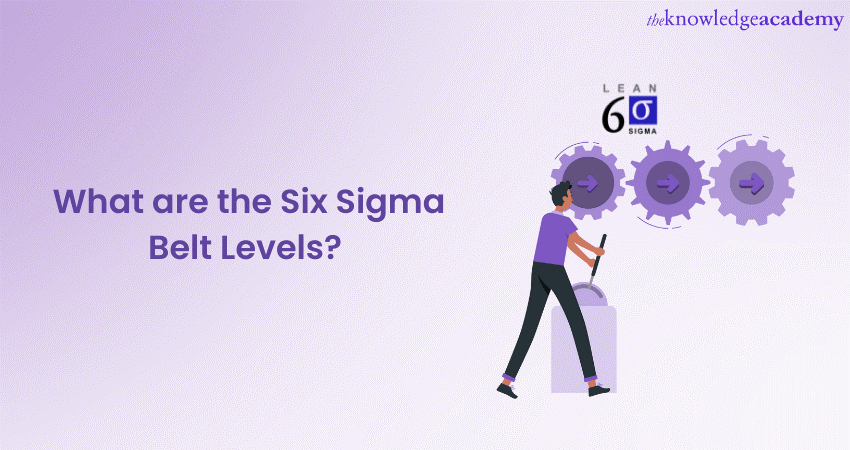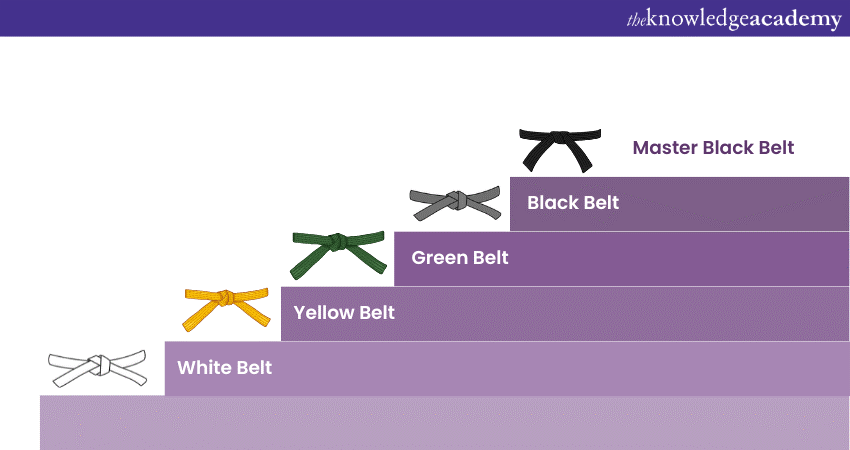We may not have the course you’re looking for. If you enquire or give us a call on 01344203999 and speak to our training experts, we may still be able to help with your training requirements.
Training Outcomes Within Your Budget!
We ensure quality, budget-alignment, and timely delivery by our expert instructors.

In today's competitive business environment, organisations strive to achieve operational excellence and deliver high-quality products and services to their customers. Six Sigma, a powerful methodology, provides a structured approach to Process Improvement and waste reduction. The various levels of expertise known as Six Sigma Belts are central to the success of Six Sigma implementation. These belts represent different levels of training and proficiency, each with its own set of responsibilities and skills.
In this blog, we will discuss different Six Sigma Belts and provide you with a comprehensive overview of their roles, responsibilities, and the knowledge they possess. We will explore the White Belt, Yellow Belt, Green Belt, Black Belt, and the highest level, the Master Black Belt. By the end of this blog, you will clearly understand each belt's significance and how they contribute to the success of Six Sigma initiatives.
Table of Contents
1) Overview of Six Sigma Belts
2) Understanding Six Sigma Belts and their levels
a) White Belt
b) Yellow Belt
c) Green Belt
d) Black Belt
e) Master Black Belt
3) Conclusion
Overview of Six Sigma Belts
The Belts in Six Sigma signify levels of expertise one possesses in Process Improvement methodologies. Starting with the entry-level ‘White Belt’, individuals progress through Yellow Belt, Green Belt, Black Belt, and finally, the Master Black Belt.
Each level represents enhanced levels of knowledge, skills, and leadership capabilities. The White and Yellow Belts provide support and contribute to project teams, while Green Belts lead smaller-scale projects. Black Belts manage complex projects and collaborate with top-level management, while Master Black Belts serve as mentors and strategic leaders. The Six Sigma belt levels offer a structured framework for personal and organisational growth in Process Improvement.

Understanding Six Sigma Belts and their levels
Further, we will discuss each of the Six Sigma Belts in detail:

1) White Belt
The White Belt level in Six Sigma represents the entry point into achieving the various Six Sigma Belts. Individuals with White Belt Certification possess a basic understanding of Six Sigma principles and terminologies. They support project teams, contribute to Process Improvement initiatives, and assist in data collection within their departments.
White Belts often undergo short training sessions introducing them to Six Sigma fundamentals. They learn to identify opportunities for improvement and play a crucial role in the initial stages of process analysis. Furthermore, while their contributions may be more limited than higher-level belts, White Belts serve as valuable team members, laying the foundation for their journey towards higher proficiency in Six Sigma
2) Yellow Belt
The Yellow Belt level signifies a deeper level of involvement and knowledge in Six Sigma methodologies. Individuals with a Yellow Belt certification undergo more extensive training, often lasting a few days, to comprehensively understand the Define, Measure, Analyse, Improve, Control (DMAIC) process.
They actively participate in project teams working alongside Green Belts and Black Belts to gather data, analyse processes, and identify areas for improvement. Yellow Belts serve as essential contributors to the Six Sigma project, providing support throughout the project life cycle.
Moreover, they play a crucial role in data collection, analysis, and assisting in implementing improvement solutions. While their responsibilities may be more focused than higher-level belts, Yellow Belts drive measurable results and foster a culture of continuous improvement.
Learn the fundamentals of Six Sigma methodology by signing up for the Six Sigma Yellow Belt Course now!
3) Green Belt
The Green Belt level represents a significant step towards becoming a proficient Six Sigma practitioner. Individuals with a Green Belt certification possess a solid understanding of statistical tools and analysis techniques, allowing them to lead smaller Process Improvement projects within their departments.
They work closely with Black Belts, providing valuable assistance in Data Analysis, Project Management, and implementation of process enhancements. Green Belts actively participate in all phases of the DMAIC process, from defining project goals to monitoring and controlling improvements.
Their role involves conducting detailed data analysis, identifying root causes, and deploying effective solutions. Green Belts play a crucial role in driving continuous improvement and achieving measurable results within their organisations, often delivering significant cost savings and process efficiency enhancements.
Assist with data collection and analysis by signing up for the Six Sigma Green Belt Training Course now!
4) Black Belt
The Black Belt level represents an advanced level of mastery in Six Sigma methodologies. Individuals with a Black Belt certification possess an in-depth understanding of Statistical Analysis, Project Management, and Change Management. They are responsible for leading and managing complex Process Improvement projects, often spanning multiple departments or organisational units.
Furthermore, Black Belts have the expertise to identify improvement opportunities, define project goals, mentor Green Belts and Yellow Belts, and deploy effective solutions. They work closely with top-level management to drive strategic initiatives and deliver substantial business benefits.
Moreover, Black Belts play a crucial role in implementing Six Sigma across the organisation, ensuring alignment with organisational goals and driving a culture of continuous improvement. Their leadership and analytical skills contribute to achieving breakthrough improvements and fostering sustainable change.
Gain a prolific Business Improvement insight by signing up for the Six Sigma Black Belt Course now!
5) Master Black Belt
The Master Black Belt level represents the highest level of expertise and experience in Six Sigma. Individuals with a Master Black Belt certification possess exceptional knowledge and proficiency in all aspects of Six Sigma methodologies. They serve as mentors, trainers, and coach Green Belts, Black Belts, and even senior leaders within the organisation.
Master Black Belts play a critical role in setting the strategic direction for Six Sigma implementation, ensuring alignment with organisational goals and objectives. They also oversee the selection and prioritisation of improvement projects, ensuring maximum impact and sustainability.
Furthermore, Master Black Belts guide and support the development of Six Sigma practitioners at all levels with their wealth of knowledge and experience. Their expertise contributes to driving significant Process Improvements, organisational excellence, and a culture of continuous learning and innovation.
Determine the correct strategy for your projects by signing up for the Six Sigma Master Black Belt Course now!
Conclusion
In this blog, we have discussed the Six Sigma Belts in detail, providing a structured framework for individuals to develop their skills and expertise in Process Improvement methodologies. Starting from the entry-level White Belt to the esteemed Master Black Belt, each level represents a progression of knowledge, responsibilities, and leadership capabilities.
Furthermore, professionals can contribute to driving measurable results, fostering a culture of continuous improvement, and achieving substantial business benefits. More importantly, embracing the principles of Six Sigma and striving for higher belt levels can enhance efficiency, quality, and success in today's competitive business landscape.
Learn to eliminate defects through Business Improvement by signing up for Six Sigma Certification Training Courses now!
Frequently Asked Questions
Upcoming Business Improvement Resources Batches & Dates
Date
 Six Sigma Green Belt
Six Sigma Green Belt
Mon 29th Jul 2024
Mon 5th Aug 2024
Mon 12th Aug 2024
Sat 17th Aug 2024, Sun 18th Aug 2024
Mon 19th Aug 2024
Tue 27th Aug 2024
Mon 2nd Sep 2024
Mon 9th Sep 2024
Sat 14th Sep 2024, Sun 15th Sep 2024
Mon 16th Sep 2024
Mon 23rd Sep 2024
Mon 30th Sep 2024
Mon 7th Oct 2024
Sat 12th Oct 2024, Sun 13th Oct 2024
Mon 14th Oct 2024
Mon 21st Oct 2024
Mon 28th Oct 2024
Mon 4th Nov 2024
Sat 9th Nov 2024, Sun 10th Nov 2024
Mon 11th Nov 2024
Mon 18th Nov 2024
Mon 25th Nov 2024
Mon 2nd Dec 2024
Sat 7th Dec 2024, Sun 8th Dec 2024
Mon 9th Dec 2024
Mon 16th Dec 2024
Mon 6th Jan 2025
Mon 13th Jan 2025
Mon 20th Jan 2025
Mon 27th Jan 2025
Mon 3rd Feb 2025
Mon 10th Feb 2025
Mon 17th Feb 2025
Mon 24th Feb 2025
Mon 3rd Mar 2025
Mon 10th Mar 2025
Mon 17th Mar 2025
Mon 24th Mar 2025
Mon 31st Mar 2025
Mon 7th Apr 2025
Mon 14th Apr 2025
Tue 22nd Apr 2025
Mon 28th Apr 2025
Tue 6th May 2025
Mon 12th May 2025
Mon 19th May 2025
Tue 27th May 2025
Mon 2nd Jun 2025
Mon 9th Jun 2025
Mon 16th Jun 2025
Mon 23rd Jun 2025
Mon 30th Jun 2025
Mon 7th Jul 2025
Mon 14th Jul 2025
Mon 21st Jul 2025
Mon 28th Jul 2025
Mon 4th Aug 2025
Mon 11th Aug 2025
Mon 18th Aug 2025
Tue 26th Aug 2025
Mon 1st Sep 2025
Mon 8th Sep 2025
Mon 15th Sep 2025
Mon 22nd Sep 2025
Mon 29th Sep 2025
Mon 6th Oct 2025
Mon 13th Oct 2025
Mon 20th Oct 2025
Mon 27th Oct 2025
Mon 3rd Nov 2025
Mon 10th Nov 2025
Mon 17th Nov 2025
Mon 24th Nov 2025
Mon 1st Dec 2025
Mon 8th Dec 2025
Mon 15th Dec 2025







 Top Rated Course
Top Rated Course


 If you wish to make any changes to your course, please
If you wish to make any changes to your course, please


